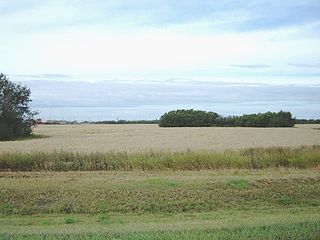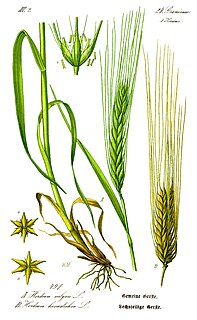
Wheat is a grass widely cultivated for its seed, a cereal grain that is a worldwide staple food. The many species of wheat together make up the genus Triticum; the most widely grown is common wheat. The archaeological record suggests that wheat was first cultivated in the regions of the Fertile Crescent around 9600 BCE. Botanically, the wheat kernel is a type of fruit called a caryopsis.

Rusts are plant diseases caused by pathogenic fungi of the order Pucciniales.

Agriculture in Russia is an important part of the economy of the Russian Federation. The agricultural sector survived a severe transition decline in the early 1990s as it struggled to transform from a command economy to a market-oriented system. Following the breakup of the Soviet Union in 1991, large collective and state farms – the backbone of Soviet agriculture – had to contend with the sudden loss of state-guaranteed marketing and supply channels and a changing legal environment that created pressure for reorganization and restructuring. In less than ten years, livestock inventories declined by half, pulling down demand for feed grains, and the area planted to grains dropped by 25%.
The cereal grain wheat is subject to numerous wheat diseases, including bacterial, viral and fungal diseases, as well as parasitic infestations.

Stem rust, also known as cereal rust, black rust, red rust or red dust, is caused by the fungus Puccinia graminis, which causes significant disease in cereal crops. Crop species that are affected by the disease include bread wheat, durum wheat, barley and triticale. These diseases have affected cereal farming throughout history. The annual recurrence of stem rust of wheat in North Indian plains was discovered by Prof. K.C. Mehta. Since the 1950s, wheat strains bred to be resistant to stem rust have become available. Fungicides effective against stem rust are available as well.

Wheat leaf rust is a fungal disease that affects wheat, barley, rye stems, leaves and grains. In temperate zones it is destructive on winter wheat because the pathogen overwinters. Infections can lead up to 20% yield loss, which is exacerbated by dying leaves, which fertilize the fungus. The pathogen is a Puccinia rust fungus. It is the most prevalent of all the wheat rust diseases, occurring in most wheat-growing regions. It causes serious epidemics in North America, Mexico and South America and is a devastating seasonal disease in India. P. triticina is heteroecious, requiring two distinct hosts.

Canada is one of the largest agricultural producers and exporters in the world. As with other developed nations, the proportion of the population agriculture employed and agricultural GDP as a percentage of the national GDP fell dramatically over the 20th century, but it remains an important element of the Canadian economy. A wide range of agriculture is practised in Canada, from sprawling wheat fields of the prairies to summer produce of the Okanagan valley. In the federal government, overview of Canadian agriculture is the responsibility of the Department of Agriculture and Agri-Food.
Agriculture in Lithuania dates to the Neolithic period, about 3,000 to 1,000 BC. It has been one of Lithuania's most important occupations for many centuries.
Barley stripe rust is a fungal disease of barley caused by Puccinia striiformis f. sp. hordei. a forma specialis of Puccinia striiformis. It was first detected in the United States in 1991, in northern and eastern Idaho in 1993, In 1995 it was detected for the first time in western Washington and western Oregon and is currently considered to be well established there. The disease initially develops at a small loci within a field and spreads rapidly and has caused significant losses in areas where climatic conditions are cool and wet.
Alternaria triticina is a fungal plant pathogen that causes leaf blight on wheat. A. triticina is responsible for the largest leaf blight issue in wheat and also causes disease in other major cereal grain crops. It was first identified in India in 1962 and still causes significant yield loss to wheat crops on the Indian subcontinent. The disease is caused by a fungal pathogen and causes necrotic leaf lesions and in severe cases shriveling of the leaves.

Agriculture in Saskatchewan is the production of various food, feed, or fiber commodities to fulfill domestic and international human and animal sustenance needs. The newest agricultural economy to be developed in renewable biofuel production or agricultural biomass which is marketed as ethanol or biodiesel. Plant cultivation and livestock production have abandoned subsistence agricultural practices in favor of intensive technological farming resulting in cash crops which contribute to the economy of Saskatchewan. The particular commodity produced is dependent upon its particular biogeography or ecozone of Geography of Saskatchewan. Agricultural techniques and activities have evolved over the years. The first nation nomadic hunter-gatherer lifestyle and the early immigrant ox and plow farmer proving up on his quarter section of land in no way resemble the present farmer operating huge amounts of land or livestock with their attendant technological mechanization. Challenges to the future of Saskatchewan agriculture include developing sustainable water management strategies for a cyclical drought prone climate in south western Saskatchewan, updating dryland farming techniques, stabilizing organic definitions or protocols and the decision to grow, or not to grow genetically modified foods. Domestically and internationally, some commodities have faced increased scrutiny from disease and the ensuing marketing issues.

Puccinia coronata is a plant pathogen and causal agent of oat and barley crown rust. The pathogen occurs worldwide, infecting both wild and cultivated oats. Crown rust poses a threat to barley production, because the first infections in barley occur early in the season from local inoculum. Crown rusts have evolved many different physiological races within different species in response to host resistance. Each pathogenic race can attack a specific line of plants within the species typical host. For example, there are over 290 races of P. coronata. Crops with resistant phenotypes are often released, but within a few years virulent races have arisen and P. coronata can infect them.

Puccinia is a genus of fungi. All species in this genus are obligate plant pathogens and are known as rusts. The genus contains about 4000 species.

Barley, a member of the grass family, is a major cereal grain grown in temperate climates globally. It was one of the first cultivated grains, particularly in Eurasia as early as 10,000 years ago. Globally 70% of barley production is used as animal fodder, while 30% as a source of fermentable material for beer and certain distilled beverages, and as a component of various foods. It is used in soups and stews, and in barley bread of various cultures. Barley grains are commonly made into malt in a traditional and ancient method of preparation.
Poland's agricultural sector is vital for European and Global market because it produces a variety of agricultural, horticultural and animal origin products. The surface area of agricultural land in Poland is 15.4 million ha, which constitutes nearly 50% of the total area of the country.

Wheat yellow rust, also known as wheat stripe rust, is one of the three major wheat rust diseases, along with stem rust of wheat and leaf rust.

Epoxiconazole is a fungicide active ingredient from the class of azoles developed to protect crops. In particular, the substance inhibits the metabolism of fungi cells infesting useful plants, and thereby prevents the growth of the mycelia. Epoxiconazole also limits the production of conidia (mitospores). Epoxiconazole was introduced to the market by BASF SE in 1993 and can be found in many products and product mixtures targeting a large number of pathogens in various crops. Crops are, for example, cereals, soybeans, banana, rice, coffee, turnips, and red as well as sugar beets.
Ruth Florence Allen (1879–1963) was an American botanist and plant pathologist and the first woman to earn her Ph.D. in botany from the University of Wisconsin. Her doctorate research focused on the reproduction and cell biology of ferns, particularly the phenomenon of apogamy. Later in her career, Allen shifted her focus to plant pathology. Her major contribution to the field of mycology was furthering the understanding of rust fungi, a group of economically important plant pathogens. Allen completed many studies on Puccinia graminis, once considered a catastrophically damaging disease-causing agent in cereal crops before the discovery of current management measures.

Edwin Butterworth Mains (1890–1968) was an American mycologist. He was known for his taxonomic research on the rust fungi (Pucciniomycetes), the genus Cordyceps, and the earth tongues (Geoglossaceae).

Margaret Brown Newton was a Canadian plant pathologist and mycologist internationally renowned for her pioneering research in stem rust Puccinia graminis, particularly for its effect on the staple Canadian agricultural product wheat.














